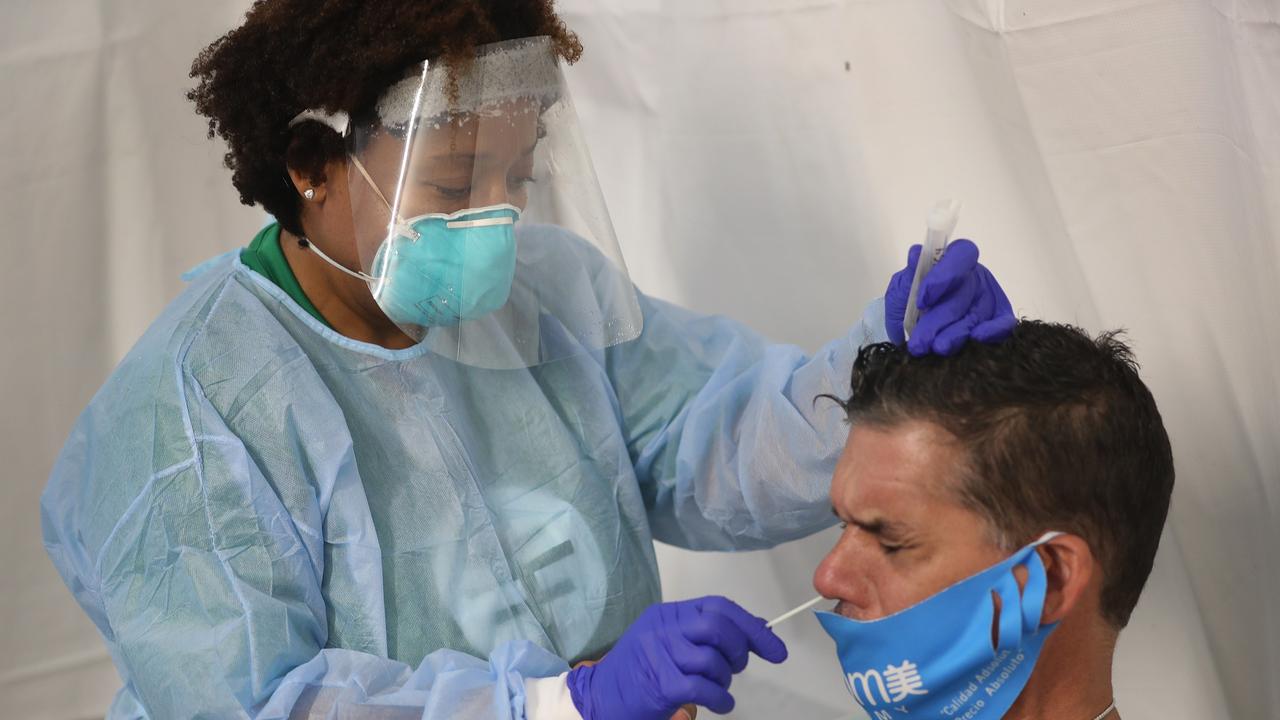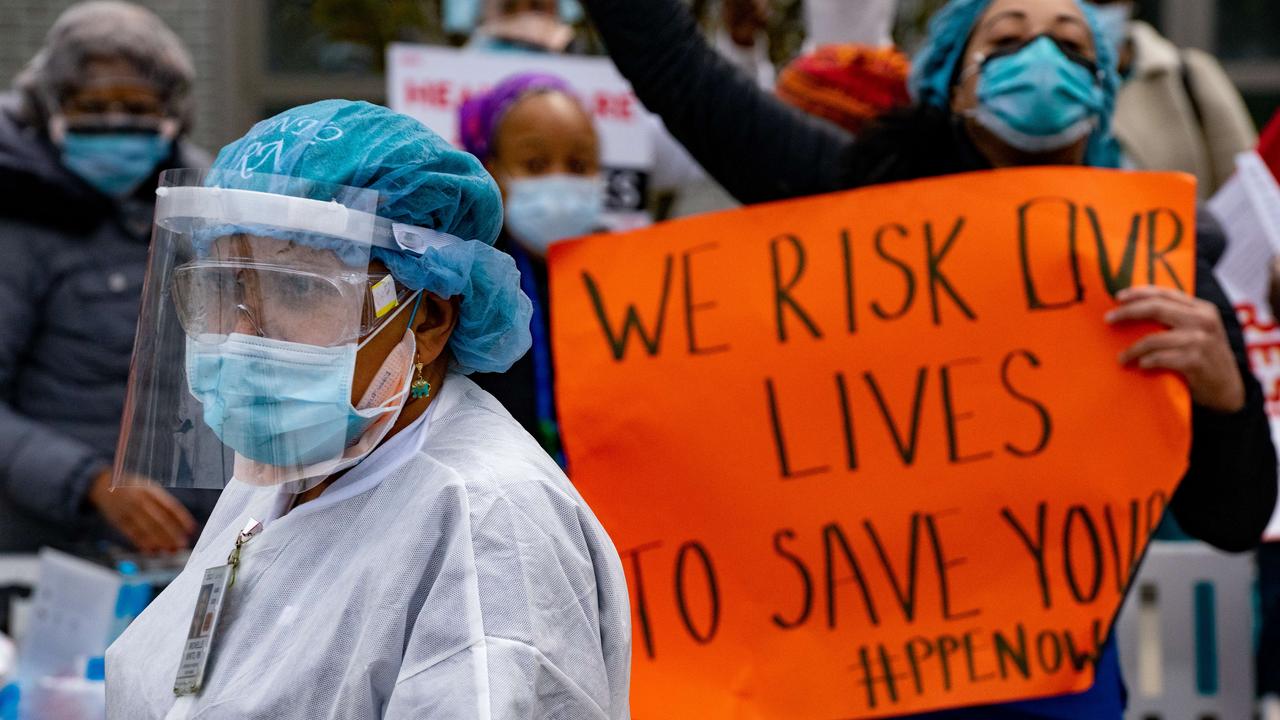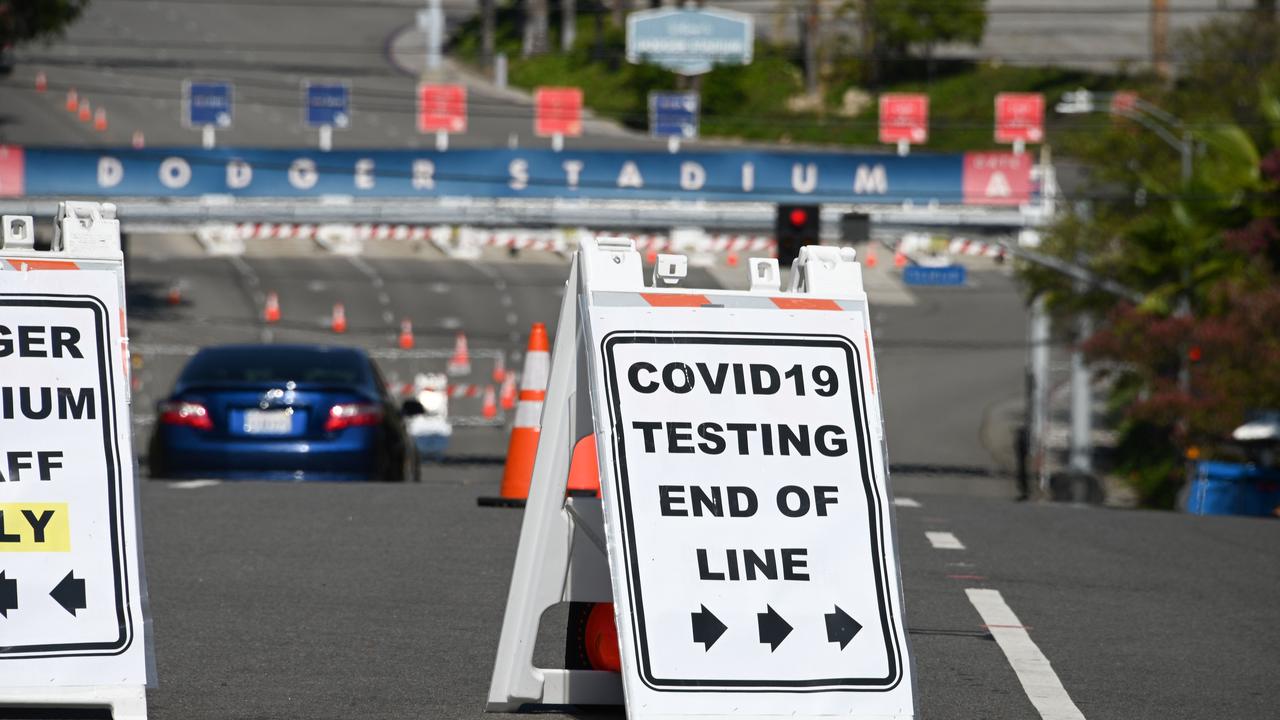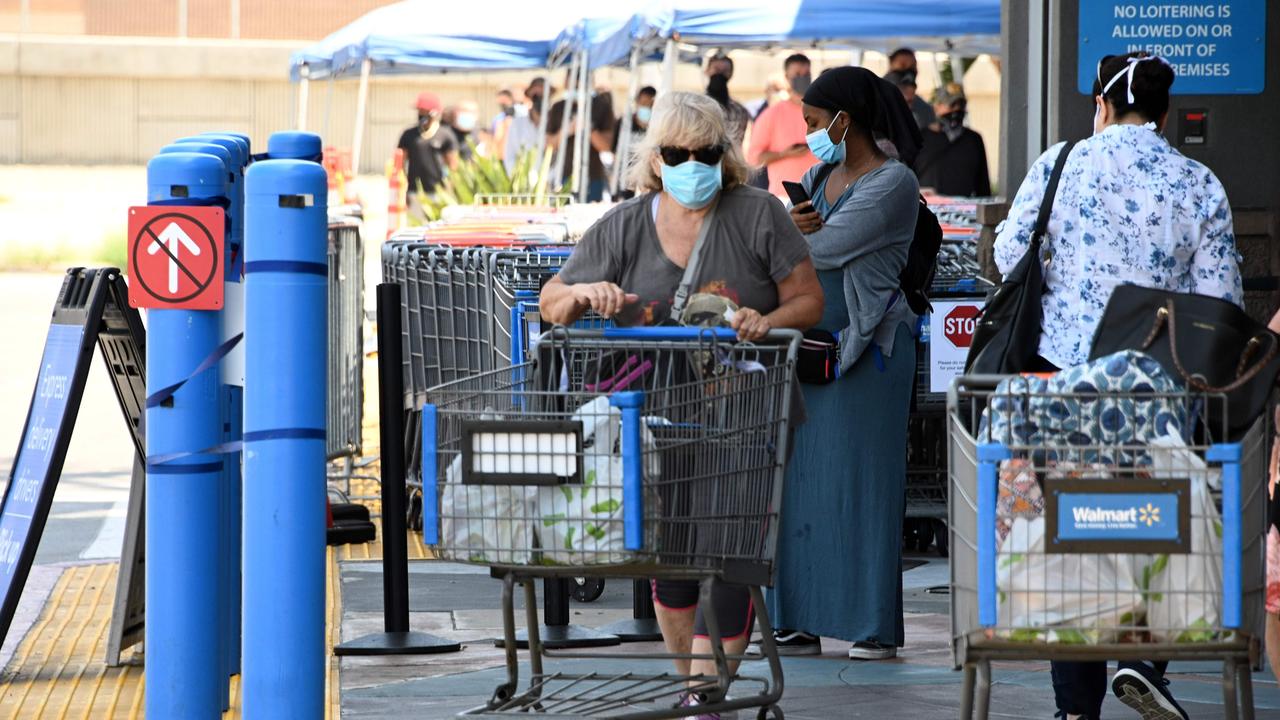Coronavirus: How the United States destroyed itself during COVID-19 pandemic
Over four million cases. A skyrocketing death toll. Hospitals in crisis. Here are six reasons things went so horribly wrong in the United States.
Statistics alone can no longer capture the severity of America’s COVID-19 situation.
The country has recorded more cases and virus-related deaths than anywhere in the world, with over four million infections and over 146,000 fatalities. With Brazil trailing in second place at 2.4 million cases, followed by India at 1.38 million, the race isn’t even close.
On July 17, the United States recorded its largest day-by-day case increase, with 77,217 new daily cases in just one day – eight thousand higher than the previous record.
RELATED: Follow our live coronavirus coverage here
Ever since the first virus case hit American shores in February, there’s been no sign of it slowing down.
A quarter of its four million cases came in the past 15 days. To give you an indication of how fast that is, consider that it took almost 100 days for the US to count its first million cases.
How did it come to this?
POPULATION SIZE
A good indicator of how a country is coping with the pandemic is to compare its population size with its infection rate.
A country with more people is likely to have more infections, so this “per capita” number of cases needs to be taken into account.
President Donald Trump has frequently made the point that the US has the most cases because it has a large population and is testing the most people:
Our Coronavirus testing is so much greater (25 million tests) and so much more advanced, that it makes us look like we have more cases, especially proportionally, than other countries. My message on that is very clear!
— Donald J. Trump (@realDonaldTrump) June 22, 2020
There is a rise in Coronavirus cases because our testing is so massive and so good, far bigger and better than any other country. This is great news, but even better news is that death, and the death rate, is DOWN. Also, younger people, who get better much easier and faster!
— Donald J. Trump (@realDonaldTrump) July 3, 2020
On the surface this sounds like obvious reasoning, but it’s disingenuous in that it fails to account for how dire the country’s situation is per capita.
The US has a population of around 328 million people, representing around four per cent of the world’s population.
But the country currently has over four million cases – over 25 per cent of the global total.
To put that into perspective: Australia, with a population of 25 million, makes up around 0.33 per cent of the world’s population.
Even with Victoria’s troubling case spike, Australia has just over 13,000 cases – or 0.08 per cent of the global total.
Of course, there are other geographical factors at play. Australia is an island and relatively isolated from the other global hot spots. But that in itself isn’t enough to justify how uniquely problematic the situation is for America.
PUBLIC MESSAGING
Public health messaging in the United States has been convoluted since day one.
Mr Trump has insisted on being at the forefront of the fight against the virus, holding numerous pandemic briefings.
During these conferences, he gave advice that ran contradictory to medical experts including saying he would not be wearing a mask and pushed to reopen the US’s economy despite protests from health officials.

Throughout the first three months of 2020, Mr Trump insisted the virus was not a cause for concern. He compared it to the common flu, despite health experts repeatedly debunking this claim.
He infamously sparked an outcry after suggesting that injecting disinfectant could be a potential solution – triggering a slew of calls to emergency rooms.
It wasn’t until the end of March that the President first acknowledged the virus was “vicious”. He has since backtracked on this, falsely claiming this week that 99 per cent of cases are “totally harmless”.
During the first week of April, the US recorded 10,000 COVID-19 deaths.
The US Centres for Disease Control – the national body responsible for co-ordinating the virus response – has also come under criticism for its handling of the pandemic. The agency has been blamed for being too slow, too beauracratic, and developing a faulty test that meant private companies had to step in to fill the void.
The World Health Organisation has also faced criticism – including from Mr Trump himself – for failing to name and shame states who were not taking strict enough measures, or impressing the seriousness of the threat on member states early enough.
The US simultaneously had to contend with divergent views of state governors and a strong libertarian streak in some areas that saw protests over businesses being placed into lockdown.
Dr Shaun Ratcliff, a lecturer in political science at the University of Sydney, said messaging about COVID-19 in Australia was comparatively coherent to the US, and stressed the seriousness of it.
“Elements of the US government, both at a state and national level, have at times downplayed the severity of the virus, and there’s obviously been some mixed messages,” he told news.com.au.
Mr Trump has more recently had a dramatic shift on the virus, stressing that the pandemic will likely get worse and urging people to wear masks.
But even still, the messaging has been mixed. Two weeks ago, when Mr Trump did finally appear in public with a mask on for the first time, he stopped short of advising the public to wear them, merely saying that “it’s fine to wear one if it makes you feel comfortable”.
‘MORE TESTING’
The Trump administration often attributes the increase in virus cases to an increase in testing.
On the surface, this may sound logical; the US is the third-most populated country in the world, and is conducting hundreds of thousands of tests per day.
At a re-election rally in Oklahoma last month, Mr Trump described it as a “double-edged sword”, claiming he ordered that testing he slowed down.
“When you do testing to that extent you’re going to find more people,” he told the crowd.
“You’re going to find more cases, so I said to my people, ‘Slow the testing down please.’
“They test and they test and we got tests — people don’t know what’s going on. We got tests, ‘We got another one over here’.”
He also blamed the “radical fake news” media for not giving him due credit, claiming he has “saved hundreds of thousands of lives”.

But it’s not as simple as this. Even factoring in the number of tests the US is conducting, the situation isn’t good.
A key problem with Mr Trump’s claim is that the rise in cases is far greater than the growth in testing.
The average number of tests conducted in the US has grown by 80 per cent since early June, to 780,000 per day, according to a recent New York Times analysis.
But 31 states show an increase in cases beyond what would be expected from expanded testing. Florida, one of the worst-hit states in the US, is reporting more than 11,000 cases per day. The analysis found that only 2400 cases per day would be expected when factoring in increased testing.
The situation is similarly dire in California, Texas and Michigan.
The Times calculated this by looking at the average positive test rate in each state for the two weeks ending June 9, and multiplied those rates by the number of tests done each day since.
“These calculations assume that the severity of the outbreak in each state would remain about the same and that positive test rates would hold as testing expanded. This is the most that cases would increase as a result of increased testing,” the report explained.
“As tests become more widely available and more people who are not sick take them, positive test rates should fall.
“Instead, the United States is seeing the opposite: More tests are being conducted, but more are coming back positive, driving case counts even higher.”
HEALTHCARE SYSTEM
The United States does not have universal healthcare. Most Americans rely on their employers for health benefits, while nearly 27 million have no health insurance at all.
In other words, tens of millions of Americans literally cannot afford to get sick. They will therefore delay getting tested for fear of the economic consequences.
Given healthcare in the US is largely delivered by private companies, they are not required to maintain reserve capacity to handle a health crisis of this magnitude.

Dr Anthony Fauci, the scientific leader of America’s COVID-19 response, has repeatedly stressed that the system is broken. “The system is not really geared to what we need right now … let‘s admit it,” he said back in March.
Earlier this month he warned the US could end up seeing 100,000 cases per day – and indeed, with a peak of over 77,000 last week, he’s not exaggerating.
“I am not satisfied with what’s going on because we are going in the wrong direction if you look at the curves of the new cases,” Dr Fauci said.“So we’ve really got to do something about that and we need to do it quickly. Clearly we are not in total control right now.”
Dr Ratcliff noted that paid sick leave – or lack of it – was also a factor. According to the Pew Research Centre, almost 25 per cent of Americans don’t have access to sick leave.
While it’s become more common in recent years, lower-income workers are far less likely to have it, and only 28 per cent of civilian workers are given 10 or more days per year. “If you’re in a job where you don’t get sick pay, you might be reluctant to take time off, even if you’re not feeling well,” he said.
SOCIAL ATTITUDES
Research from the United States Studies Centre has found that Americans are relatively less likely to be compliant with lockdowns.
According to public opinion research, two-thirds of Australians said that the measures are “about right” with no partisan variation.
Just 36 per cent of Americans say the same, with 51 per cent of Trump supporters saying lockdowns and social distancing have gone too far. Six per cent of Biden supporters expressed this view too.
“These deep partisan divisions are arguably both a symptom and cause of America’s struggle to contain the COVID-19 pandemic,” the USSC report said.
Dr Ratcliff, who was part of this research team, said the coronavirus had become just another partisan issue in the United States. “The response in the US has become at least partially a partisan issue, where a lot of conservative media outlets in particular have played down the seriousness of the virus and the appropriateness of restrictions on mobility to combat it,” he told news.com.au.

“In Australia, we can find common ground on a lot of things, while in the US it’s actually really difficult to find a topic that Democrats and Republicans can agree on,” Dr Ratcliff said. “Unfortunately, COVID-19 has become just another topic where there is element of partisan disagreement, with Republicans in particular believing the lockdowns have gone too far.”
REOPENING TOO QUICKLY
Experts said a key problem was that the country’s more problematic states were trying to re-open themselves too quickly.
Speaking on Podcast-19 earlier this month, America’s top infectious diseases expert Dr Anthony Fauci said states like Florida and Arizona ignored the recommended guidelines on how to reopen, proceeding too quickly to get their economies moving again.
“Certainly Florida I know jumped over a couple of checkpoints,” Dr Fauci said.
“It’s pretty obvious that in some states, the governors or the mayors essentially jumped over the guidelines and the checkpoints, and opened up a little bit too soon. They were not prepared to deal with the resurgences that they saw.”

He said young people in particular “threw caution to the wind, and you see films of people very densely congregated at bars and in areas where they’re not looking at social distancing or wearing masks”.
“I think what we’re seeing right now are the results of that, in four states that are accounting for 50 per cent of new infections.”
The four states Dr Fauci was referring to were Florida, Arizona, California and Texas.
The median age of those infected in Florida – the new epicentre for COVID-19 – has plummeted from 65 years old at the beginning of March to 39, suggesting younger, healthier people are transmitting the virus.
WHAT’S NEXT FOR THE US?
The situation in the US looks increasingly grim. Hospitals and labs are under severe strain – and that’s just from the people who go to hospital.
The Centres for Disease Control and Prevention estimated the true case total is probably 10 times greater than what’s officially been recorded. A total of 12 states have recorded infections of over 100,000.
Based on its trajectory, the country will have easily surpassed five million cases within the next fortnight. And that might be one of the most alarming stats of all.



